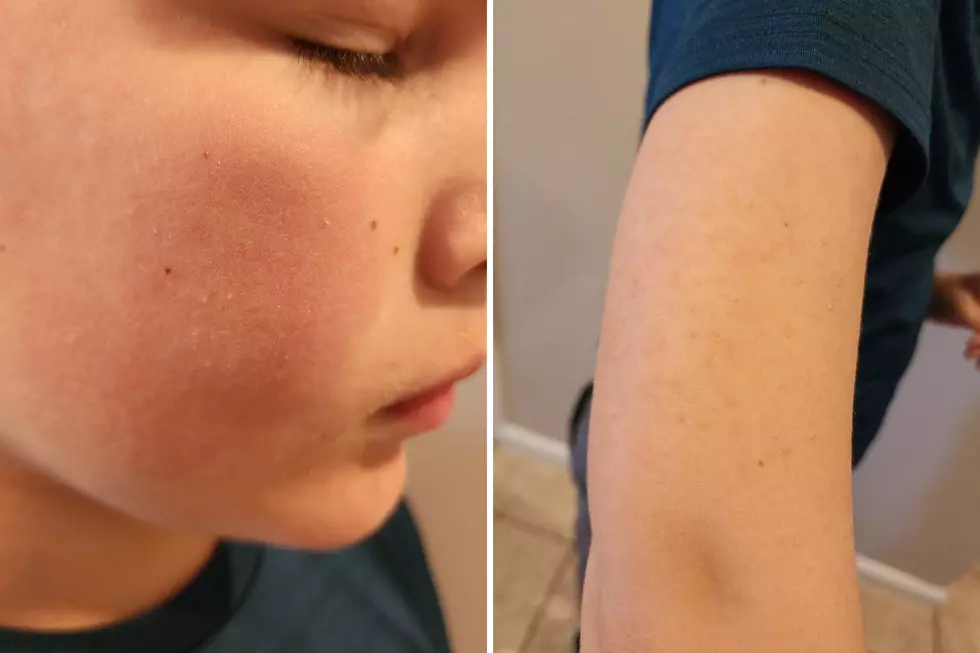
‘Slapped cheek disease’ is raging through NJ schools right now
My son stayed home from school yesterday, and a quick trip to his pediatrician confirmed he had a classic case of Fifth Disease. Also known as Slapped-Cheek Disease, it is known for causing a bright red rash on the face and body, in addition to low-grade fever and flu-like symptoms.
Until recently, I had not heard of Fifth Disease — even though it is very common in school-age children, and highly contagious. It has been rolling through our local school system and our network of friends for several weeks now. So I wanted to share what I've learned about the virus, and why there is only minor reason for concern.
(Note: I am a concerned parent and a scientist, but not a doctor or medical professional.)

What is Fifth Disease?
Fifth Disease is more technically known as Erythema infectiosum and Parvovirus B19. Familiarly, it is called Slapped-Cheek Disease. It is a viral infection that is common among children from 5 to 15 years old. It is highly contagious.
According to the Centers for Disease Control, Fifth Disease infections most often occur in late winter, spring, and early summer. Minor outbreaks happen every few years.
Why is it called Fifth Disease?
According to Cleveland Clinic, it is so named because it became the fifth viral skin rash known to infect children, in a checklist of six. In case you are curious, here is the list:
1.) Measles
2.) Scarlet fever
3.) Rubella (German measles)
4.) Dukes' disease
5.) Erythema infectiosum (Fifth disease)
6.) Roseola
Why is it known as Slapped-Cheek Disease?
A bright red rash on the cheeks is the classic telltale sign of Fifth Disease. They look like they have been slapped. Hence, the colloquial name.
What are the classic symptoms?
In addition to the face, a "lacey" rash can occur on the torso, arms, and legs. The rash usually appears within 4 to 14 days of infection, and may become itchy or irritating.
The rash is actually the last phase of the virus. Other earlier symptoms mimic those of the flu, and may include:
—Low-grade fever (99 to 101 degrees Fahrenheit)
—Headache
—General fatigue
—Joint pain and swelling
—Sore throat
—Runny nose
About 20% of children who contract Fifth Disease exhibit no symptoms at all, but are still contagious.
How does Fifth Disease spread?
The virus is transmitted through respiratory or blood droplets, most often by coughing, sneezing, or talking.
Pregnant women can also spread the Fifth Disease virus to their unborn child.
Note: The red skin rash is not contagious.
Can adults get it?
Yes, but it is rare. Most people who contract Fifth Disease as a child develop a natural immunity to it by adulthood.
Any serious complications?
Healthy children and adults rarely face serious or long-term problems from the disease.
Those with blood disorders or a weakened immune system are at increased risk for low blood cell production and other complications. This includes those with cancer, HIV, anemia, and a transplanted organ.
Also, if a pregnant woman passes Fifth Disease to their unborn child, it can cause significant complications and danger.
How long does it last?
Initial flu-like symptoms only last a few days. The subsequent rash usually fades after 5 to 10 days, but may last 2 to 3 weeks.
Can cats or dogs get it?
No. Parvovirus B19 can not be passed from humans to other animals. It is different from the parvoviruses that affect dogs and cats.
What do I do if you suspect your child has Fifth Disease?
Whenever your child exhibits flu-like symptoms, the CDC encourages common sense preventative measures:
—Wash hands often with soap and water
—Cover mouth and nose when coughing or sneezing
—Try not to touch eyes, nose, and mouth
—Avoid close contact with sick people
—Stay home when you are sick
Fifth Disease infections are usually mild, and do not generally require a doctor's visit or hospital stay.
What treatment is usually advised?
Because Fifth Disease is viral, and not a bacterial infection, antibiotics will not work.
Doctors generally recommend rest and over-the-counter medicine to relieve symptoms. You might consider acetaminophen or ibuprofen for fever and joint pain. And lotion or other topical creams for itching.
Those who experience complications or are pregnancy with a Fifth Disease infection may require additional treatment or precautions.
When should you keep your child home from school?
The Harvard Medical School recommends children stay absent from school or daycare if they have one of the "big four" sickness symptoms:
1.) Fever
2.) Vomiting or diarrhea (not a symptom of Fifth Disease)
3.) Bad pain
4.) Non-stop coughing or breathing changes (not a symptom of Fifth Disease)
Remember, once the "slapped-cheek" rash shows up, the virus is no longer contagious.
Cough, cough: NJ's favorite lost voice and sore throat remedies
Gallery Credit: Dan Zarrow
Dan Zarrow is Chief Meteorologist for Townsquare Media New Jersey. Check out Dan's weather blog or follow him on Facebook for your latest weather forecast updates.
10 Nasty Illnesses We See Every Year in New Jersey
Gallery Credit: Megan Carter
More From 92.7 WOBM






